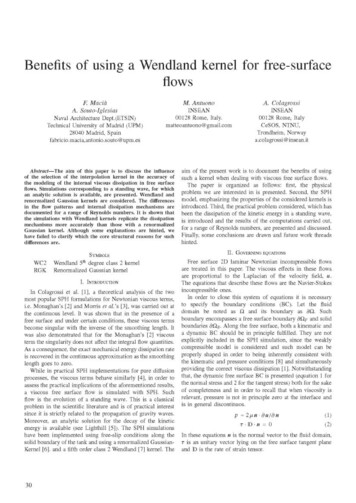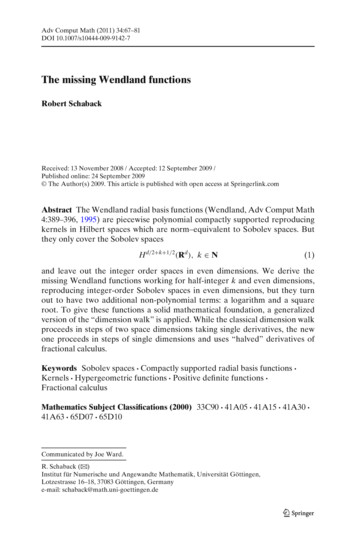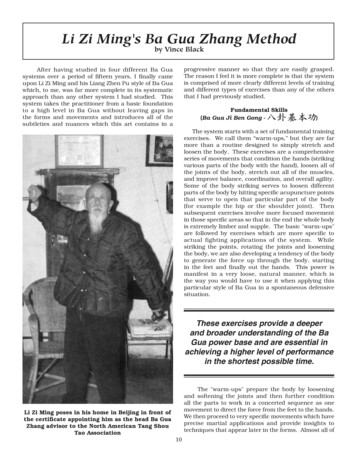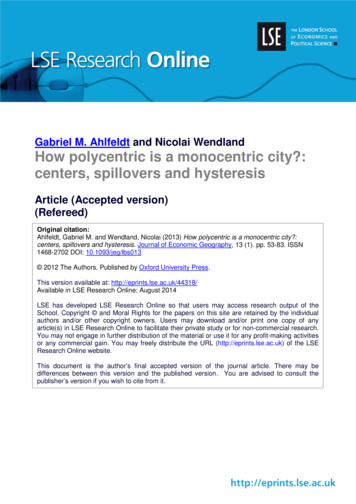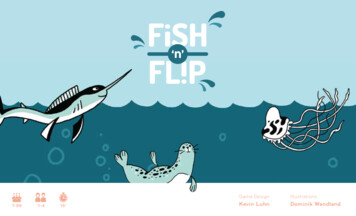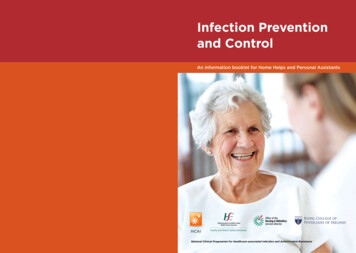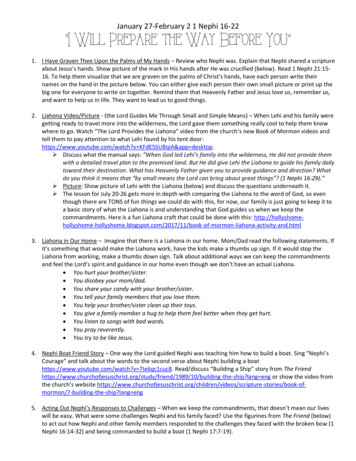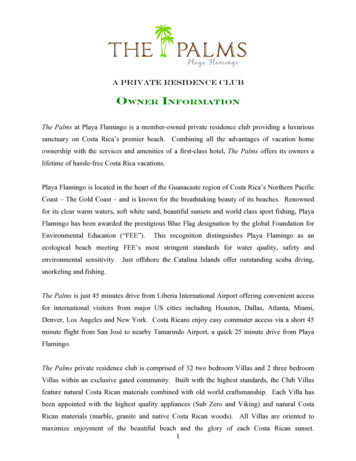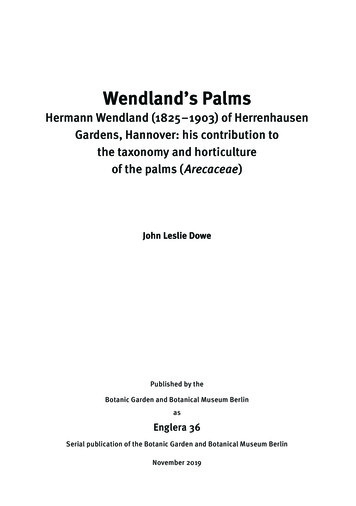
Transcription
Wendland’s PalmsHermann Wendland (1825 – 1903) of HerrenhausenGardens, Hannover: his contribution tothe taxonomy and horticultureof the palms ( Arecaceae )John Leslie DowePublished by theBotanic Garden and Botanical Museum BerlinasEnglera 36Serial publication of the Botanic Garden and Botanical Museum BerlinNovember 2019
Englera is an international monographic series published at irregular intervals by the Botanic Gardenand Botanical Museum Berlin (BGBM), Freie Universität Berlin. The scope of Englera is originalpeer-reviewed material from the entire fields of plant, algal and fungal taxonomy and systematics,also covering related fields such as floristics, plant geography and history of botany, provided that itis monographic in approach and of considerable volume.Editor: Nicholas J. TurlandProduction Editor: Michael RodewaldPrinting and bookbinding: Laserline Druckzentrum Berlin KGEnglera online access: Previous volumes at least three years old are available through JSTOR:https://www.jstor.org/journal/engleraEnglera homepage: https://www.bgbm.org/engleraSubmission of manuscripts: Before submitting a manuscript please contact Nicholas J. Turland,Editor of Englera, Botanic Garden and Botanical Museum Berlin, Freie Universität Berlin, KöniginLuise-Str. 6 – 8, 14195 Berlin, Germany; e-mail: n.turland@bgbm.orgSubscription: Verlagsauslieferung Soyka, Goerzallee 299, 14167 Berlin, Germany; e-mail: kontakt@soyka-berlin.de; https://shop.soyka-berlin.de/bgbm-pressExchange: BGBM Press, Botanic Garden and Botanical Museum Berlin, Freie Universität Berlin,Königin-Luise-Str. 6 – 8, 14195 Berlin, Germany; e-mail: bgbmpress@bgbm.org 2019 Botanic Garden and Botanical Museum Berlin, Freie Universität BerlinAll rights (including translations into other languages) reserved. No part of this publication may bereproduced, stored in a retrieval system or transmitted in any form or by any means, electronic, mechanical, photocopying, recording or otherwise, without the prior written permission of the publisher.ISSN 0170-4818ISBN 978-3-946292-31-9Financial support: This publication has been sponsored by:Australian Tropical Herbarium, James Cook University, Smithfield, Queensland, Australia.Friends of the Botanic Gardens Cairns, Cairns, Queensland, Australia.Palm & Cycad Societies of Australia, Milton, Queensland, Australia.Citation: Dowe J. L. 2019: Wendland’s Palms. Hermann Wendland (1825 – 1903) of HerrenhausenGardens, Hannover: his contribution to the taxonomy and horticulture of the palms (Arecaceae). –Berlin: Botanic Garden and Botanical Museum Berlin, Freie Universität Berlin. – Englera 36.Address of the author: Dr. John Leslie Dowe, Australian Tropical Herbarium, James Cook University, Smithfield, Queensland 4878, Australia; e-mail: john.dowe@jcu.edu.auCover design: Front cover: Pritchardia pacifica, from Bonplandia (10: t. 15. 1862). – Back cover:Metroxylon vitiense, from Seemann B., Flora Vitiensis (t. 80. 1868, as Sagus vitiensis). – See Fig. 35 (p.62) and Fig. 34 (p. 61), respectively, in this volume.
Contents5ContentsSummary and key words . . . . . . . . . . . . . . . . . . . . . . . . . . . . . . . . . . . . . . . . . . . . . . . . . . . . . . . . 7Acknowledgements . . . . . . . . . . . . . . . . . . . . . . . . . . . . . . . . . . . . . . . . . . . . . . . . . . . . . . . . . . . . . 8Introduction . . . . . . . . . . . . . . . . . . . . . . . . . . . . . . . . . . . . . . . . . . . . . . . . . . . . . . . . . . . . . . . . . . . 9Material and methods . . . . . . . . . . . . . . . . . . . . . . . . . . . . . . . . . . . . . . . . . . . . . . . . . . . . . . . . . . 10Hermann Wendland and the Herrenhausen “dynasty” . . . . . . . . . . . . . . . . . . . . . . . . . . . . . . 11The Berggarten palm collection . . . . . . . . . . . . . . . . . . . . . . . . . . . . . . . . . . . . . . . . . . . . . . . . 12New Palm House, the Berggarten, 1880 . . . . . . . . . . . . . . . . . . . . . . . . . . . . . . . . . . . . . . . . . 16Hermann Wendland: palm taxonomy and nomenclature . . . . . . . . . . . . . . . . . . . . . . . . . . . . . 19Wendland’s palm classification system . . . . . . . . . . . . . . . . . . . . . . . . . . . . . . . . . . . . . . . . . . 20Taxonomic palm lists in books . . . . . . . . . . . . . . . . . . . . . . . . . . . . . . . . . . . . . . . . . . . . . . . . . 23Wendland’s publications . . . . . . . . . . . . . . . . . . . . . . . . . . . . . . . . . . . . . . . . . . . . . . . . . . . . . . 25Taxonomic output . . . . . . . . . . . . . . . . . . . . . . . . . . . . . . . . . . . . . . . . . . . . . . . . . . . . . . . . . . . . . 27American genera . . . . . . . . . . . . . . . . . . . . . . . . . . . . . . . . . . . . . . . . . . . . . . . . . . . . . . . . . . . 27Chamaedorea . . . . . . . . . . . . . . . . . . . . . . . . . . . . . . . . . . . . . . . . . . . . . . . . . . . . . . . . . . 27Geonoma . . . . . . . . . . . . . . . . . . . . . . . . . . . . . . . . . . . . . . . . . . . . . . . . . . . . . . . . . . . . . . 35Bactris . . . . . . . . . . . . . . . . . . . . . . . . . . . . . . . . . . . . . . . . . . . . . . . . . . . . . . . . . . . . . . . . 39Syagrus . . . . . . . . . . . . . . . . . . . . . . . . . . . . . . . . . . . . . . . . . . . . . . . . . . . . . . . . . . . . . . . 40Malortiea [Reinhardtia] . . . . . . . . . . . . . . . . . . . . . . . . . . . . . . . . . . . . . . . . . . . . . . . . . . 40Washingtonia . . . . . . . . . . . . . . . . . . . . . . . . . . . . . . . . . . . . . . . . . . . . . . . . . . . . . . . . . . . 42Welfia . . . . . . . . . . . . . . . . . . . . . . . . . . . . . . . . . . . . . . . . . . . . . . . . . . . . . . . . . . . . . . . . . 45Other regional treatments . . . . . . . . . . . . . . . . . . . . . . . . . . . . . . . . . . . . . . . . . . . . . . . . . . . . . 46Africa . . . . . . . . . . . . . . . . . . . . . . . . . . . . . . . . . . . . . . . . . . . . . . . . . . . . . . . . . . . . . . . . . 46Caribbean region (including Florida) . . . . . . . . . . . . . . . . . . . . . . . . . . . . . . . . . . . . . . . . 49Indian Ocean islands: Seychelles, Mascarenes, Comoros and Madagascar . . . . . . . . . . . 53Fiji and Samoa . . . . . . . . . . . . . . . . . . . . . . . . . . . . . . . . . . . . . . . . . . . . . . . . . . . . . . . . . . 58Tuamotu Islands . . . . . . . . . . . . . . . . . . . . . . . . . . . . . . . . . . . . . . . . . . . . . . . . . . . . . . . . 63Micronesia . . . . . . . . . . . . . . . . . . . . . . . . . . . . . . . . . . . . . . . . . . . . . . . . . . . . . . . . . . . . . 63New Caledonia . . . . . . . . . . . . . . . . . . . . . . . . . . . . . . . . . . . . . . . . . . . . . . . . . . . . . . . . . . 63Asia . . . . . . . . . . . . . . . . . . . . . . . . . . . . . . . . . . . . . . . . . . . . . . . . . . . . . . . . . . . . . . . . . . 67Australia and Palmae Australasicae . . . . . . . . . . . . . . . . . . . . . . . . . . . . . . . . . . . . . . . . . 70Etymology . . . . . . . . . . . . . . . . . . . . . . . . . . . . . . . . . . . . . . . . . . . . . . . . . . . . . . . . . . . . . . . . . . . 75Conclusion . . . . . . . . . . . . . . . . . . . . . . . . . . . . . . . . . . . . . . . . . . . . . . . . . . . . . . . . . . . . . . . . . . . 77References . . . . . . . . . . . . . . . . . . . . . . . . . . . . . . . . . . . . . . . . . . . . . . . . . . . . . . . . . . . . . . . . . . . 78Appendix 1. Names of taxa in the Arecaceae associated with Hermann Wendland . . . . . . . . . . . . . . 89Appendix 2. Publications on palms by Hermann Wendland . . . . . . . . . . . . . . . . . . . . . . . . . . . . 128Index to scientific names . . . . . . . . . . . . . . . . . . . . . . . . . . . . . . . . . . . . . . . . . . . . . . . . . . . . . . . 131TablesTable 1. Comparative equivalents of the major groups of classification of Arecaceae byMartius, Wendland and Dransfield & al. . . . . . . . . . . . . . . . . . . . . . . . . . . . . . . . . . . . . . .Table 2. Hermann Wendland’s palm classification system . . . . . . . . . . . . . . . . . . . . . . . . . . . .Table 3. The classification outline of Palmae Australasicae . . . . . . . . . . . . . . . . . . . . . . . . . .Table 4. Palm species and genera named for Hermann Wendland . . . . . . . . . . . . . . . . . . . . . .21227476
Summary and key words7Summary“H. Wendl.” is a prominent author citation associated with the taxonomy and nomenclature ofArecaceae (the palm family), and refers to theGerman botanist Hermann Wendland (1825–1903), who was among the world’s foremostspecialists of the palm family in the mid- tolate nineteenth century. Wendland representedthe third generation of one of the most eminenthorticultural/botanical “dynasties” of Europe,following his father, Heinrich Ludolph Wendland (1792–1869) and his grandfather, JohannChristoph Wendland (1755–1828). After anapprenticeship under his father, and extensivetravels through Europe, Hermann Wendlandembarked on developing the Berggarten, oneof the component gardens of the Royal Gardensof Herrenhausen, Hannover, as a major centreof palm horticulture and research, establishingEurope’s largest living collection of cultivatedpalms, an extensive herbarium and Europe’stallest glasshouse, in which the palm collectionwas displayed. Wendland achieved praise fromhis peers as a consummate cultivator of palmsand was active in horticultural expositions andbotanical congresses. His taxonomic work onpalms extended to all parts of the world, andhe developed fruitful collaboration with otherbotanists on large monographs and regionaltreatments, working with botanists such as Oscar Drude, August Grisebach, William BottingHemsley, Jean Linden, Gustav Mann, BertholdSeemann, Richard Spruce and others. An examination of the major online taxonomic databases for Arecaceae, in the World Checklist ofSelected Plant Families (Govaerts & al. 2016 )and the International Plant Names Index (IPNI2017 ), as well as additional broad literaturesearches, generated a list of 549 nomenclatu-ral novelties (see Appendix 1) associated withWendland. The names were verified for issuesof valid publication, legitimacy, priority and authorship. Names associated with Wendland aredefined thus: either Wendland was an author ofthe names, or they were ascribed to Wendlandby other authors, or they are new combinationsor names at new rank based on such names (sothat “H. Wendl.” appears in the author citationof the names). The 549 names are at the ranksof subtribe (two), genus (62), subgenus (22),section (nine), species (422), subspecies (14)and variety (18). Also listed are 164 names associated with Wendland that were not validlypublished. Altogether, the names represent 60currently accepted genera and 249 species, although these numbers are open to interpretationdepending on taxonomic opinion. Of the currently accepted names, 44 at the rank of genusand 134 at the rank of species are associatedwith Wendland. This list is not intended to be ataxonomic revision of the names, but a historical record of names associated with Wendland.Wendland is associated with more palm generathan any other botanist and his legacy forms thebasis for much of the contemporary taxonomicwork on palms. A complete list of publicationsby Wendland on the palms is also included (Appendix 2).Key words: Arecaceae, Palmae, HermannWendland, Herrenhausen Gardens, Berggarten,palms, nomenclature, taxonomy, horticulture,plant collecting, herbarium specimens, biography, Oscar Drude, August Grisebach, WilliamBotting Hemsley, Jean Linden, Gustav Mann,Carl von Martius, Ferdinand Mueller, BertholdSeemann, Richard Spruce.
8AcknowledgementsAcknowledgementsI thank the following, who have assisted withaccess to archives, library materials and publications: Marc Appelhans, University of Göttingen; Guido Braem, Lahnau, Germany; LisaDeCesare, Harvard University Herbaria Library;Denis Diagre-Vanderpelen, Jardin BotaniqueMeise, Belgium; Meg Lloyd, Queensland Museum Library; Sara Maroske, Mueller Correspondence Project, Royal Botanic Gardens Victoria; Lyn Mason [descendant of Jacob Storck],Cairns, Australia; Megan Prance, QueenslandHerbarium Library; Hubert Rettich, Germany;Markus Wiederer, University of Würzburg;Nicole Schuermans-Ceulemans [great-greatgranddaughter of Jean Linden], Belgium; DieterSchulz, Naturhistorische Gesellschaft Hannover;Sally Stewart, Royal Botanic Gardens VictoriaLibrary; Sophie von Schwerin, ILF Institute forLandscape and Open Space, Switzerland. I amparticularly grateful to Nicholas Turland, Botanic Garden and Botanical Museum Berlin, FreieUniversität Berlin (BGBM) for his assistanceand patience in resolving many nomenclaturalissues. The reviewers are thanked for providing constructive suggestions for improvementsto the manuscript: Hans Walter Lack, BGBM;Larry R. Noblick, Montgomery Botanical Center; Fred W. Stauffer, Conservatoire et Jardin botaniques de la Ville de Genève, and two anonymous reviewers.
Introduction9IntroductionThe mid- to late nineteenth century can be described as the “golden age” of palm horticultureand taxonomy. Palm collections, associated withhorticultural establishments, private collectorsand botanic gardens were rapidly expanding asboth trade and movement of plant collectors andbotanists around the world facilitated an increasing flow of new palm species into European gardens and specimens into herbaria. It was a timeof profound advances in botanical science thatultimately resulted in the completion of numerous general and regional floristic treatments formany parts of the world. It was also a time whentaxonomic specialization was facilitated, and thework of botanists such as Wendland was able tocome to fruition.Hermann Wendland (1825–1903) was amongEurope’s most active and productive palm taxonomists and horticulturists in the three decades of 1850–1880 (Regel 1891; Anon. 1903a,1903b, 1903c; Wittmack 1903; Wagenitz 1972;Grayum & Nevers 1988; Hodel 1992; Knoll2005; Peters 2013; Schwerin 2013). In a reviewof the historical aspects of the rate of taxonomicestablishment of palm genera over time, Tomlinson (1989) noted that “Hermann Wendland’sname is associated with more palm genera thanany other botanist”, and because so many ofWendland’s names are still accepted suggestedthat “he was particularly good at the naming aspect of his craft”. Apart from his comprehensivecontribution to palm taxonomy and horticulture,Wendland had other noteworthy achievements,such as the introduction of some of the mostpopular, and economically important, ornamental plants in the world. Among these are Anthu rium scherzerianum Schott (Araceae), the flamingo flower (W. 1875; Morren & De Vos 1887;Anon. 1903a; Sheela 2008); Saintpaulia ionan tha H. Wendl. (Gesneriaceae), the African violet(Pilon 2012); Tillandsia ionantha Planch. (as T.erubescens H. Wendl.) (Bromeliaceae), the airplant; and Billbergia viridiflora H. Wendl. (Bro meliaceae) (Wendland 1854a).
10Material and methodsMaterial and methodsOriginal publications were examined in the libraries of the Queensland Herbarium (BRI), theRoyal Botanic Gardens Victoria (MEL) and theQueensland Museum. Online publications wereaccessed through the Biodiversity Heritage Library and the HathiTrust Digital Library. Archival materials were obtained from the GottfriedWilhelm Leibniz Bibliothek, Hannover; theLibrary of Botanic Garden Meise; the Herbarium, Library, Art and Archives, Royal BotanicGardens, Kew; the Harvard University Herbaria Library; the Naturhistorische GesellschaftHannover; the University of Florence, ScienceLibrary, Botany Archives; and the Mueller Correspondence Project Archives, Royal BotanicGardens Victoria. Additional references weresourced through the libraries of the Queensland Herbarium (BRI), the Australian TropicalHerbarium (CNS), the National Herbarium ofVictoria (MEL) and James Cook University.German and French quotations were translatedto English by the author. Author comments oradditions within the quotations are in brackets.Original spelling (when in English) and punctuation have been maintained. High-resolutionimages of original illustrations of species associated with Wendland were digitized, and manyof them are presented here. See the introductionto Appendix 1 for the materials and methodsused there.
Hermann Wendland and the Herrenhausen “dynasty”11Hermann Wendland and the Herrenhausen “dynasty”[Johann Bernhard Daniel] Hermann Wendland(born 11 October 1825; died 12 January 1903)(Fig. 1) represented the third generation of oneof the most eminent gardening/botanical “dynasties” of Europe (Volz 2006). Following his father, Heinrich Ludolph Wendland (1792 – 1869)and his grandfather, Johann Christoph Wendland(1755 – 1828), Hermann Wendland held directorial/botanical positions at the Royal Gardens ofHerrenhausen, Hannover, Germany (Stafleu &Cowan 1988; Peters 2013; Rettich 2016). Seemann (1865) succinctly summarized the botanical contribution of the three generations ofWendlands:perience in practical horticulture and botany.Wendland first spent May – September 1846 atthe Royal Botanic Garden in Schöneberg nearBerlin as a volunteer gardener under Carl DavidBouché, then in September 1846 to July 1847 inAustria at the Imperial Gardens at Schönbrunnnear Vienna where he received horticulturaltraining and botanical instruction from the aroidologist Heinrich Wilhelm Schott. After this,he spent a short time working in the garden ofBaron Charles von Hügel at Hietzing near Vienna. At this time, Hügel was President of theImperial Royal Horticultural Society and a fullthe Botanic Gardens at Herrenhausen, whereone of the richest and rarest collections ofplants, and the most complete set of palms,is now cultivated. The name of the gardenis honourably associated with the history ofbotany. It was here where Ehrhardt, a pupilof Linnaeus, wrote his Beiträge [Ehrhardt1787 – 1792], the elder Wendland his workson ericas [Wendland 1798 – 1823], and in connection with Schrader his Sertum [Schrader& Wendland 1795 – 1798], his son, a work onphyllodineous acacias [Wendland 1820], andin conjunction with Bartling a monograph ofDiosmeae [Bartling & Wendland 1824]; andhis grandson (Hermann Wendland), numerous papers on the palms and allied orders.After completing early education at the CourtSchool in Herrenhausen in 1841, Wendland wasapprenticed by his father as a gardener until 1844.He received private tuition in French, English,Latin and illustration. In 1845, he enrolled in twosemesters at the Georg-August University Göttingen where he received botanical tuition fromFriedrich Gottlieb Bartling (1798 – 1875), director of the Botanic Garden and former universitycolleague of Hermann’s father Heinrich, who coauthored with him a number of botanical works(see Bartling & Wendland 1824, 1824 – 1825).In 1846, his father organized a three-year travelplan for his son as a “journeyman” to gain ex-Fig. 1. Miniature portrait of Hermann Wendland,1895, 67 56 mm [painting by Carl Georg LouisBostelmann]. Gottfried Wilhelm Leibniz Bibliothek.member of the Imperial Academy of Sciences(Hügel 1903). In late 1847, Wendland travelledto Switzerland and Italy, after which he workedfor the horticulturalist Lambert Jacob-Makoy atLiège in Belgium. From Liège, he went to theRoyal Botanic Gardens, Kew, England, wherehe remained in 1848 – 1849. At Kew, Wendlandworked under William Jackson Hooker, and es-
Hermann Wendland: palm taxonomy and nomenclature19Hermann Wendland: palm taxonomy and nomenclatureWendland’s interest in palms became global. Although much of his taxonomic output comprisedregional accounts, he was productive in generictreatments and the ongoing description of single genera and species as information came tohand. He was very active with American palms,where he followed a tradition established bybotanists such as Jacquin, Karsten, Kunth, Martius, Spruce, Trail and Wallace, among others(Karsten 1847, 1858 – 1869; Martius 1823 – 1853;Wallace 1853; Spruce 1871; McVaugh 1955;Sánchez 2006). Wendland travelled in CentralAmerica 1856 – 1857, thus adding to the tradition. In other areas such as Africa, Australasia,and in the Pacific Ocean, no such tradition hadbeen forged and palm collecting and taxonomyhad been largely taken up by visiting Europeancollectors and botanists whose enterprise relatedto broad floristic treatments rather than individual families such as the palms. An exceptionto this in the Australasian region was the workof Baron Ferdinand von Mueller (1825 – 1896)(Fig. 7), Victorian Government Botanist at theMelbourne Botanic Gardens, who had established himself as the region’s most influentialand productive taxonomist (Home & al. 2002;Maroske 2006). Mueller, however, played noparticular attention to the palms with regard tomonographic treatments, and most of his palmtaxonomy involved single or small groups ofspecies promptly described as he received specimens of them from his network of collectors inAustralasia (Dowe & Maroske 2016). Mueller’smost active period with regard to palm taxonomywas 1865 – 1880, during which he named 19 newtaxa, and also a time that somewhat coincidedwith that of Wendland’s most active years. Although initially reluctant to “share” taxonomicwork on Australian palms, Mueller, over time,assigned palm taxonomy to specialists such asBavarian botanist, explorer and palm specialistCarl Friedrich Philipp von Martius (1794 – 1868)(Mueller 1868), George Bentham (1800 – 1884)(Mueller 1872), Wendland (Mueller undated)and Odoardo Beccari (1843 – 1920) (Mueller1885, 1887a, 1887b; Beccari 1885).Wendland’s sources of herbarium specimensand propagation materials included his own collections made in Central America in 1856 – 1857,those made by numerous collectors and most ofwhich were subsequently returned to botanicalinstitutions in Europe, and species that werethen being cultivated in European gardens andglasshouses and for which the precise nativeorigins were sometimes not known or otherwiseunclear (Hodel 1992). Wendland was associatedwith many palm names that were mentioned incorrespondence, horticultural publications andtechnical reports, hence the use of the authorcitation “H. Wendl. ex. -----” for many names(see Kerchove de Denterghem 1878; Salomon1887). Conversely, Wendland applied formalpublication of names that had been informallyused by other authors, hence the author citationFig. 7. Baron Ferdinand von Mueller (1825 – 1896),circa 1874 – 1884 [photograph by J. W. Lindt]. StateLibrary of Victoria.
Taxonomic output – Americas – Chamaedorea27Taxonomic outputAs background to the list of names presented inAppendix 1, the following sections outline mostof Wendland’s enduring palm taxonomy. In thetext, Wendland’s original name appears first andif now a synonym, the current name follows insquare brackets.American generaTwenty-three genera of American palms wereestablished by Wendland. Of these, 12 are currently accepted and 11 have been reduced tosynonymy. The currently accepted genera,in chronological order of publication includeSyne chanthus (Wendland 1858a); Calyptrogyne(Wendland 1859a); Dictyocaryum and Iriartella(Wendland 1860a); Gaussia (Wendland 1865b);Welfia (Regel 1869); Rhapidophyllum (Drude1876); Washingtonia (Wendland 1879a); Acoe lorrhaphe (Wendland 1879b); Asterogyne andPholidostachys (Hooker 1883); and Pseudo phoenix (Sargent 1886). Those reduced to synonymy include Malortiea [Reinhardtia] (Wendland 1853a); Eleuthero petalum [Chamaedorea](Oersted 1859); Catoblastus [Wettinia] (Wendland 1860b); Porothrinax [Thrinax] (Grisebach1866); Acanthorhiza [Cryosophila] (Linden1869); Diglossophyllum [Serenoa] (Schaedtler1875); Diodosperma [Trithrinax]; (Wendland1878b); Lepidococcus [Mauritiella] (Kerchovede Denterghem 1878); Chamaephoenix [Pseu dophoenix] (Curtiss 1887); Sargentia [Pseu dophoenix] (Salomon 1887); and Chamaethri nax [Trithrinax] (Pfister 1892). In addition toestablishing new genera, Wendland also madesignificant contributions adding new speciesto existing genera, in particular Chamaedorea,Geonoma and Bactris. Outlines for each ofthese genera, and others of significance, are presented below.ChamaedoreaOf all the genera that Wendland worked on,Chamaedorea is the one for which he is mostremembered. The first new palm species to beformally described by Wendland were Chamae dorea species in a series of three papers eachdescribing a single new species. The first wasC. geonomiformis (Fig. 8), described from cultivated plants in Herrenhausen Gardens originally collected by Józef Warscewicz in Guate mala (Wendland 1852b). This was followed bythe description of C. ernesti-augusti (Fig. 9),described from a cultivated plant collected byLinden in Mexico in 1847. The species wasnamed to honour Ernst August I, King of Hannover (1771 – 1851) (Wendland 1852c). The last paper in the series described C. pygmaea, based oncultivated specimens at Herrenhausen collectedby Linden in Colombia (Wendland 1852d).In 1853, Wendland provided a revised delimitation of Chamaedorea, which supported themaintenance of a closely related genus Moreniafor which he described new species and subspecies. Morenia was established by Ruiz & Pavon(1794) based on specimens gathered in Peru.Wendland’s new taxa included M. oblongata [C.sartorii] and M. oblongata var. conferta [C. sar torii] (Wendland 1853b).Another six Chamaedorea species were described in a continuing series of two papers.These included C. martiana [C. cataractarum],which Wendland named “to honour the palmspecialist, Dr von Martius”; C. lepidota [C.liebmannii]; and C. lindeniana [C. catarac tarum], named to honour “Mr Linden of Brussels”, which were published in a paper aboutnew species from Central America (Wendland1853c). The remaining three species were C.desmoncoides [C. elatior], C. karwinskyana [C.pochutlensis] and C. resinifera [C. elatior] andwere described in a paper concerning the “C.elatior complex” and related species (Wendland1853d). Chamaedorea karwinskyana was namedfor Wilhelm Friedrich Karwinski von Karwin(1780 – 1855), a Hungarian naturalist based inBavaria, who travelled in Brazil 1821 – 1826 andMexico 1826 – 1832, 1840 – 1843 (HUH 2016a).As palms and other decorative tropical plantswere increasingly being grown in Europe at thistime (Bolle 1858), Wendland (1854b) compiledhis Index Palmarum, Cyclanthearum, Panda nearum, Cycadearum. In the introduction he
28Taxonomic output – Americas – ChamaedoreaFig. 8. Chamaedorea geonomiformis (as Nunnezharia geonomiformis). Bot. Mag. 100: t. 6088.1874 [W. Fitch del. et lith.]. Royal Botanic Gardens Victoria Library.
Taxonomic output – Americas – ChamaedoreaFig. 9. Chamaedorea ernesti-augusti, female plant. Bot. Mag. 81: t. 4831. 1855 [W. Fitch del. etlith.]. Royal Botanic Gardens Victoria Library.29
Taxonomic output – Australia and Palmae AustralasicaeFig. 42. Archontophoenix cunninghamiana and Ptychosperma elegans (as Seaforthia elegans). Bot. Mag. 83: t. 4961. 1857 [W. Fitch del. et lith.]. The illustration is a mixture of two species: fig. 1 – 6 depict A. cunninghamiana (the lectotype of the basionym, Ptychosperma cunninghamianum, see Dowe 2010: 175) while fig. 7 – 11 depict P. ele gans. Royal Botanic Gardens Victoria Library.71
78ReferencesReferencesAitchison J. E. T. 1882: On the flora of KuramValley, &c., Afghanistan. Part II. – J. Linn.Soc., Bot. 19: 139 – 200.Ames O. & Correll D. S. 1952: Orchids of Guatemala. – Fieldiana, Bot. 26(1): i – xiii, 1 – 395.André E. 1871a: Welfia regia, H. Wendland. Wel fia royal. – Ill. Hort. 18: 93 – 94, t. 62.André E. 1871b: Verschaffeltia melanochaetesH. Wendland. – Ill. Hort. 18: 54, t. 54.André E. 1874a: Geonoma gracilis, Linden &André. – Ill. Hort. 21: t. CLXIX.André E. 1874b: Pritchardia pacifica, B. Seemann. Pritchardia de l’Ocean Pacifique. –Ill. Hort. 21: 27 – 28, t. CLXI.André E. 1883a: Veitchia joannis. – Rev. Hort.55: 344 – 345.André E. 1883b: Exposition Internationale dela Société Royale d’Agriculture et de Botanique de Gand. – Rev. Hort. 55: 205 – 210.André E. 1883c: Pritchardia vuylstekeana. –Rev. Hort. 55: 329 – 330.Anon. 1857: Reisende. – Bot. Zeitung (Berlin)15: 278 – 280.Anon. 1865a: [Editorial]. – Gard. Chron. 1865:292.Anon. 1865b: The thief palm (Phoenicophoriumsechellarum, Herm. Wendl.). – J. Bot. 3:353 – 354.Anon. 1866: Botanical Congress. – Gard. Chron.1866: 490 – 491.Anon. 1870: Garden memoranda. M. Linden’sestablishment at Brussels. – Gard. Chron.1870: 865 – 866.Anon. 1875a: [Editorial]. – Gard. Chron., n.s.,4: 270.Anon. 1875b: Science notes. Botany. Palms. –Academy, Weekly Rev. 8(173): 228.Anon. 1875c: Cologne International Horticultural Exhibition. – Gard. Chron., n.s., 4: 294.Anon. 1878: Report of the Council. [CharlesPickering]. – Proc. Amer. Acad. Arts 13:441 – 444.Anon. 1886: Litteratur. – Gartenflora 35: 93 – 95.Anon. 1903a: Hermann Wendland. – Möller’sDeutsche Gärtn.-Zeitung 18: 47 – 48.Anon. 1903b: Obituary (Hermann Wendland). –Gard. Chron., ser. 3, 33: 58.Anon. 1903c: Hermann Wendland. – Bull. Misc.Inform. Kew 1: 29.Anon. 2016: History of the U.S. Herbarium. –Smithsonian National Museum of NaturalHistory. – Published at t [accessed April2016].Auhagen [R.] 1882: Das neue Palmenhaus aufdem Königl. Berggarten zu Herrenhausen. –Gart.-Zeitung (Berlin) 1: 6 – 11.Baikie W. B. 1856: Narrative of an exploringvoyage up the rivers Kwo’ra and Bi’nue(commonly known as the Niger and Tsádda)in 1854. – London: John Murray.Balfour I. B. 1877: Palmae. – Pp. 379 – 388 in:Baker J. G. (ed.), Flora of Mauritius and theSeychelles. – London: L. Reeve & Co.Bartling F. G. & Wendland H. L. 1824: Dios meae: descriptae et illustratae. – Göttingen:Vandenhoeck & Ruprecht.Bartling F. G. & Wendland H. L. 1824 – 1825:Beiträge zur Botanik. 2 vols. – Göttingen:Vandenhoeck und Ruprecht.Beccari O. 1885: Reliquiae Schefferianae. –Ann. Jard. Bot. Buitenzorg 2: 77 – 171.Beccari O. 1889: Le palme del genere Pritchar dia. – Malesia 3: 281
Wendland. The names were verified for issues of valid publication, legitimacy, priority and au-thorship. Names associated with Wendland are defined thus: either Wendland was an author of the names, or they were ascribed to Wendland by other authors, or they are new combinations or names at new rank based on such names (so

